The Highest-End Notebooks, 2009
by Jarred Walton on October 14, 2009 3:10 AM ESTGeneral Windows Performance
Quite a few people have asked for some general performance numbers in terms of Windows boot/shutdown, hibernate/resume, and sleep/wake times. These vary quite a bit between runs, depending on what you've been doing on the computer. If you have a bunch of open applications, it will take longer for the system to enter sleep mode for example. We performed these tests on these notebooks from an empty Windows desktop, and we used the best-case result for each system. As a side note, these tests benefit from a fast SSD, providing more consistent results and better times. However, as we will see, these desktop systems are all quite slow when it comes to booting up and shutting down -- or hibernating or sleeping even.

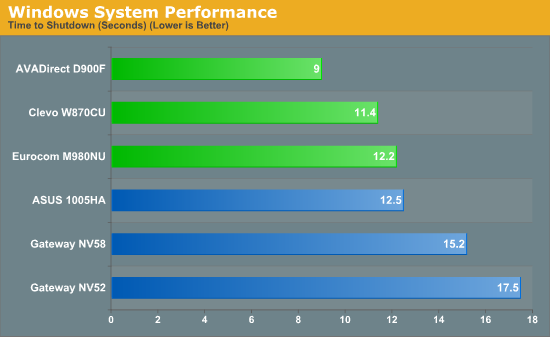
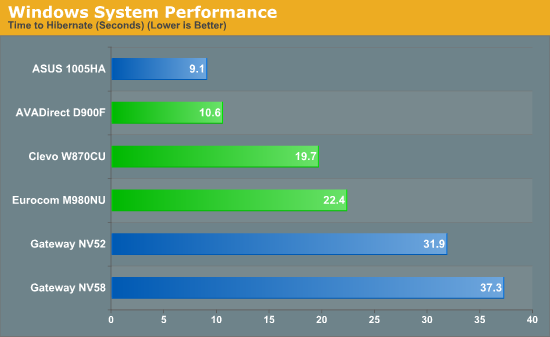
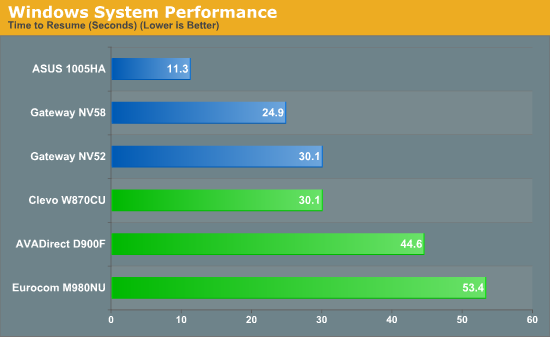
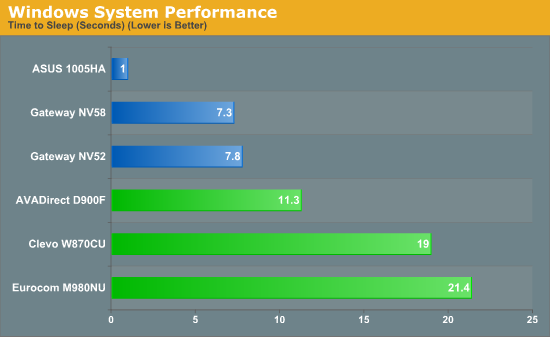
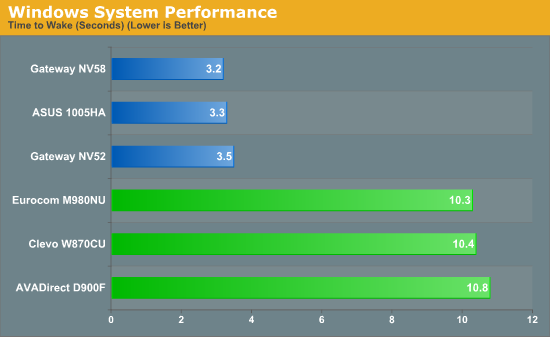
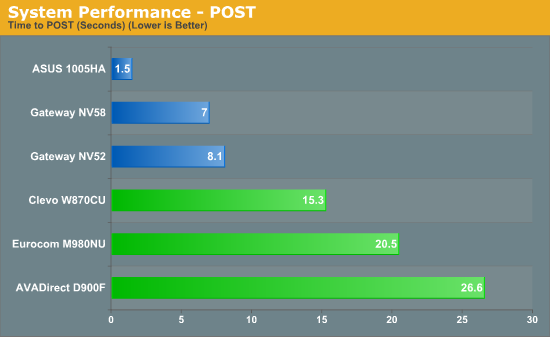
The results are a mixture of good and bad -- and keep in mind we are comparing these notebooks with relatively inexpensive laptops. The three notebooks place at the top in shutdown times, and they also do quite well in the hibernate test, but everywhere else they trail behind the ASUS netbook and Gateway laptops. In some of the tests, there's a huge difference -- like the extremely poor sleep and wake times. Keep in mind that the Gateway notebooks also have 4GB RAM, so outside of the 6GB D900F we're dealing with the same amount of memory.
What the OS performance charts don't tell you is that the boot and resume times are hugely influenced by POST times, so we added that chart. The ASUS netbook will POST in under two seconds, the Gateway notebooks take 7-8 seconds, and it only gets worse from there. The W870CU is the fastest of the high-end notebooks when it comes to POST time: 15.3 seconds. The Eurocom M980NU requires a lengthy 20.5 second POST, and at the back of the pack is the D900F: 26.5 seconds! We can cut the D900F a bit of slack since the RAID set adds an extra 7.5 seconds, but regardless of these notebooks could be dramatically improved in this area. The D900F takes almost as long to POST as it does to load the OS, while the POST times on the other two notebooks only account for one third of the boot time. Ugh.
This is one area where the simplicity of netbooks is truly a benefit, but there's no reason more complex notebooks can't POST a lot faster. We would like to set a goal for all notebook manufacturers: get your system to POST in at most 5 seconds and we will be content. If ASUS and other netbook manufacturers can achieve abbreviated POST times of less than 2 seconds, we don't think that's too much to ask.










56 Comments
View All Comments
MonicaS - Friday, October 30, 2009 - link
I think the best way to get a high end laptop is to build one. Obviously you are very limited in what you can with a laptop over a desktop, but still the options are enough. The obvious upgrades are HD and Ram. On that note you can Raid to SSD's and put in some serious ram on a 64 bit machine and have a incredibly fast machine. The other benefit of this is that you can basically pick your own laptop to upgrade and not have to buy fugly one.Monica S
Los Angeles Computer Repair
http://www.sebecomputercare.com">http://www.sebecomputercare.com
Shadowmaster625 - Thursday, October 22, 2009 - link
"Unfortunately, 60GB isn't enough space to install even a small subset of our gaming benchmarks"All you have to do is move the game folders to the big drive when you're not using them, and move them back over to C:\Program Files when you need to use them. It takes all of 2 minutes (or 10 seconds for a multitasker) and is surely smarter than wasting hundreds of dollars on bigger SSDs, no? Are we that lazy?
Draxanoth - Thursday, October 22, 2009 - link
I see a lot of complaints for no good reason in these comments. If you don't like them, don't buy them. Complaining about something you don't own nor want sounds like bitterness at the price tag.I have an M570etu, which is the dual core version of the GTX280 Clevo model with the orange trim. It's a lot better looking in person, those pictures are awful. 3.2ghz I think but I'd have to check. My battery life is 3 hours non-gaming. It easily functions as both a mobile and a gaming machine. I don't have any problems with Call of Pripyat in HD either. i7 in a laptop is overkill, and if you want one with a decent battery life that's a poor choice. Why is anyone surprised by that?
Meaker10 - Saturday, October 17, 2009 - link
You can already get official mobile drivers for all laptops for windows 7 the same version as the desktop set for the HD 2,3 and 4 series.JarredWalton - Saturday, October 17, 2009 - link
True, but the real question will be whether this is a one-time thing (because Win7 is launching and ATI has to have valid drivers or they'll be in deep trouble), or if this is a change going forward. I'm inclined to think it's just for the Win7 launch, since they don't provide mobile drivers for anything besides Win7. Vista and XP users are still the vast majority of people and will be for a good while to come, and there are laptop users that literally haven't received updated ATI drivers in years.I'll keep an eye on things, and hopefully ATI will change their stance officially at some point. At present, searching for ATI Mobility Radeon drivers for XP and Vista only gives you the choice of X1800 or earlier GPUs. It looks like perhaps the integrated HD 3200 on laptops might also have up-to-date drivers in XP/Vista, but discrete GPU laptop owners are out of luck for now if they don't upgrade to Win7.
jmhorridge - Saturday, October 17, 2009 - link
I and my work colleagues must regularly fly to other countries for a week or two, and there perform computations (economic forecasting) that can occupy a quad-core for 2 or 3 hours. These big DTR laptops (or luggables) are the only way to get the job done. Battery life is not an issue -- always used plugged in.An mATX system (with monitor) would weigh twice as much, might not suit all voltages, and, in a suit case, would bust the flight weight allowance. However, everyone is allowed to carry on a laptop -- no matter how big.
I'm very pleased to see such machines reviewed.
Mark Horridge
Kishkumen - Friday, October 16, 2009 - link
"it appears most notebook manufacturers are convinced users aren't interested in matte LCDs anymore."Then they are wrong and I will not buy their product. I've passed up some pretty awesome notebooks over the past couple of years. Looks like I'll be passing up many more. If I'm the only one who can't stand glossy displays, then so be it, but I'd rather go without then pay good money for something that is the visual equivalent of fingernails on a chalkboard for me.
EBH - Thursday, October 15, 2009 - link
Falcon NW should have been in the review. Their machines > than any Aienwarehttp://www.falcon-nw.com/">http://www.falcon-nw.com/
JarredWalton - Friday, October 16, 2009 - link
I'm not sure why you say Falcon is so much better than Alienware. They're basically the same thing as AVADirect, but with far fewer options.Fragbox DRX = Clevo D900F with custom paint.
Fragbox TLX = MSI MS-1722 (GX720) with custom paint.
I/O = MSI MS-1361 (X340)with... yup, custom paint.
AVADirect also offers all three of those, with optional custom paint. Pricing definitely isn't in favor of FNW, though perhaps they have better customer service. Let's see, using as close to identical options as I can get (including custom paint on the AVADirect models):
D900F AVADirect = $4545
Fragbox DRX = $6086
MSI GX720 AVADirect = $2229
Fragbox TLX = $2625
MSI X340 AVADirect = $1292
I/O = $1727
I think the main draw of Falcon is if you want a special paint job with some custom image (i.e. not just the Exotix Single Color option). That can add over $1000, but at least then you have something truly unique. Anyway, inasmuch as performance and features are concerned, Falcon was in this review, albeit indirectly. The same goes for WidowPC and ProStar and anyone else that uses whitebook chassis.
nortexoid - Thursday, October 15, 2009 - link
I'm sure most would be better off buying a desktop (of the same caliber) and a cheap netbook for mobility, and for the same price as these ghastly beasts.The only market I can see for these things is someone who goes to LANs more often than he should, and who would rather port around a 10lb+ notebook than a desktop + LCD or all-in-one. But this has to be a very small niche market.